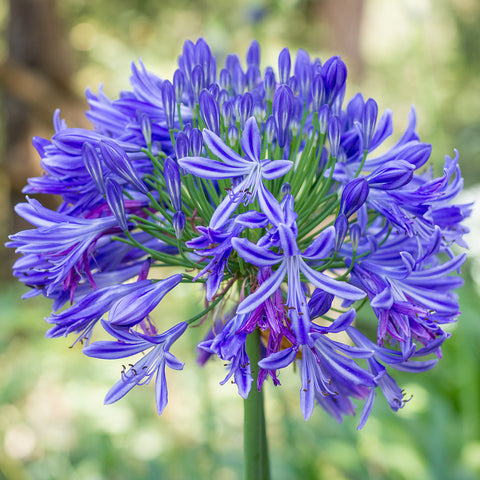Seasonal Agapanthus Care: Planning For Winter Season and Summer season
Seasonal Agapanthus Care: Planning For Winter Season and Summer season
Blog Article
Understanding the Art of Agapanthus Treatment: Necessary Steps for Healthy Development and Dynamic Blossoms
In the realm of gardening, the cultivation of agapanthus stands as a satisfying venture for those that seek to support these stylish flowering plants. With their striking flowers and graceful foliage, agapanthus has captured the interest of gardeners worldwide. However, achieving optimal growth and vibrant blossoms requires a nuanced technique that encompasses various necessary steps. From selecting the right selection to mastering trimming methods, the journey towards growing growing agapanthus plants is multifaceted and holds the key to unlocking the complete capacity of these botanical gems.

Selecting the Right Agapanthus Variety

When selecting the right Agapanthus range for your yard, consider variables such as environment viability, flower shade, and growth behavior. In addition, think about the climate in your area to make sure the Agapanthus range you select can flourish in your particular problems. Comprehending the growth habit of different Agapanthus selections is critical for appropriate placement within your yard.
Suitable Growing Problems
Thinking about the optimal environmental needs is crucial for successful Agapanthus farming. Agapanthus plants are delicate to cool temperatures and must be protected from frost throughout winter season months.
To make sure healthy and balanced development and vivid blooms, plant Agapanthus light bulbs at a depth of regarding 2-4 inches and room them 8-12 inches apart. Mulching around the base of the plants assists keep dampness and reduces weed growth.
Watering and Fertilizing Tips
Preserving proper wetness degrees and giving necessary nutrients are key elements in the treatment program for Agapanthus plants. When it comes to watering Agapanthus, it is crucial to strike a balance. These plants like continually damp soil but are at risk to root rot if overwatered.
Fertilizing Agapanthus is important for advertising healthy development and prolific blossoms. Apply a well balanced plant food, such as a 10-10-10 formula, in the early springtime as new growth arises. Repeat this application every 6-8 weeks throughout the expanding period. Avoid excessive fertilizing, as it can lead to lush foliage at the expenditure of blossoms. Constantly adhere to the supplier's instructions for proper dilution and application methods. By complying with these watering and feeding tips, you can guarantee your Agapanthus plants flourish and generate vivid, lasting blooms.
Trimming Methods for Agapanthus
Pruning Agapanthus plants at the ideal times and with proper methods is essential for keeping their wellness and promoting ideal development and flowering. The optimal time to prune Agapanthus remains in late winter season or early springtime prior to brand-new development arises. Begin by removing any kind of yellowing or dead leaves near the base of the plant. Cut them as short as feasible without harming the emerging shoots.
For flowered stems, wait until the blossoms have actually perished and afterwards trim them back to the base. This not only cleans the plant's appearance but additionally urges the development of new flower buds. Deadheading invested flowers can also redirect the plant's energy into producing even more blooms instead than setting seeds. Nevertheless, if you desire to gather seeds for propagation, leave some blossoms to mature and dry on the Extra resources plant.
Keep in mind to make use of tidy, sharp devices to make exact cuts and lower the risk of presenting illness. Agapanthus. Normal trimming will certainly assist maintain your Agapanthus looking healthy and balanced and cool while making certain an abundant display of lovely flowers
Managing Usual Insects and Conditions
After browse this site making certain appropriate trimming methods for Agapanthus, it is essential to resolve typical insects and diseases that can affect the wellness and vigor of these plants. Agapanthus plants are typically sturdy yet can still succumb to specific concerns. One typical bug that affects Agapanthus is the Agapanthus gall midge. This small, orange fly lays its eggs in the foliage, resulting in distorted development and blossom buds that fail to open. To battle this parasite, trim and destroy any afflicted plant parts and think about using insecticidal soap.
Another typical problem is fungal leaf area, which offers as dark lesions on the fallen leaves. To prevent fungal diseases, make sure great air blood circulation around the plants, stay clear of overhead watering, and get rid of any kind of contaminated leaves quickly. Furthermore, Agapanthus plants can deal with origin rot if they are planted in poorly draining pipes dirt. To avoid this, plant Agapanthus in well-draining soil and avoid overwatering. By being vigilant and taking punctual click here to find out more activity versus illness and bugs, you can aid your Agapanthus plants thrive and create vibrant blooms.

Final Thought
To conclude, understanding the art of agapanthus treatment involves picking the appropriate range, providing optimal planting conditions, appropriate watering and feeding, ideal pruning techniques, and resolving common pests and conditions. By adhering to these necessary steps, you can make certain healthy and balanced growth and lively flowers for your agapanthus plants. Keep in mind to regularly monitor and preserve your plants to promote their general wellness and longevity.
To make sure healthy and balanced development and dynamic blooms, plant Agapanthus bulbs at a deepness of concerning 2-4 inches and space them 8-12 inches apart. By complying with these watering and fertilizing pointers, you can ensure your Agapanthus plants thrive and generate dynamic, durable blossoms.
One common insect that impacts Agapanthus is the Agapanthus gall midge. In addition, Agapanthus plants can suffer from root rot if they are planted in badly draining pipes dirt. By following these essential steps, you can make sure healthy development and vivid flowers for your agapanthus plants.
Report this page